Comprehensive Auditing Report on Biotechnology Ltd's Financials
VerifiedAdded on 2021/06/14
|10
|1688
|105
Report
AI Summary
This report provides a detailed financial audit of Biotechnology Ltd, encompassing an analytical review of its financial statements and an assessment of its ability to continue as a going concern. The analysis utilizes ratio analysis, including gross margin, net profit margin, cash flow margin, liquidity ratios (current and quick ratios), solvency ratios (debt to equity), and market performance ratios. The report highlights Biotechnology Ltd's challenges, such as negative net profit margins, declining cash flow, and potential difficulties in meeting short and long-term debt obligations. The assessment of going concern reveals significant doubts about the company's ability to continue operations, primarily due to the failure of a cash injection deal and the resulting decline in share prices. The report concludes that Biotechnology Ltd lacks the capacity to operate as a going concern, given its financial instability and external factors impacting its business. The report includes references to relevant accounting standards and literature and an appendix with detailed ratio analysis data.
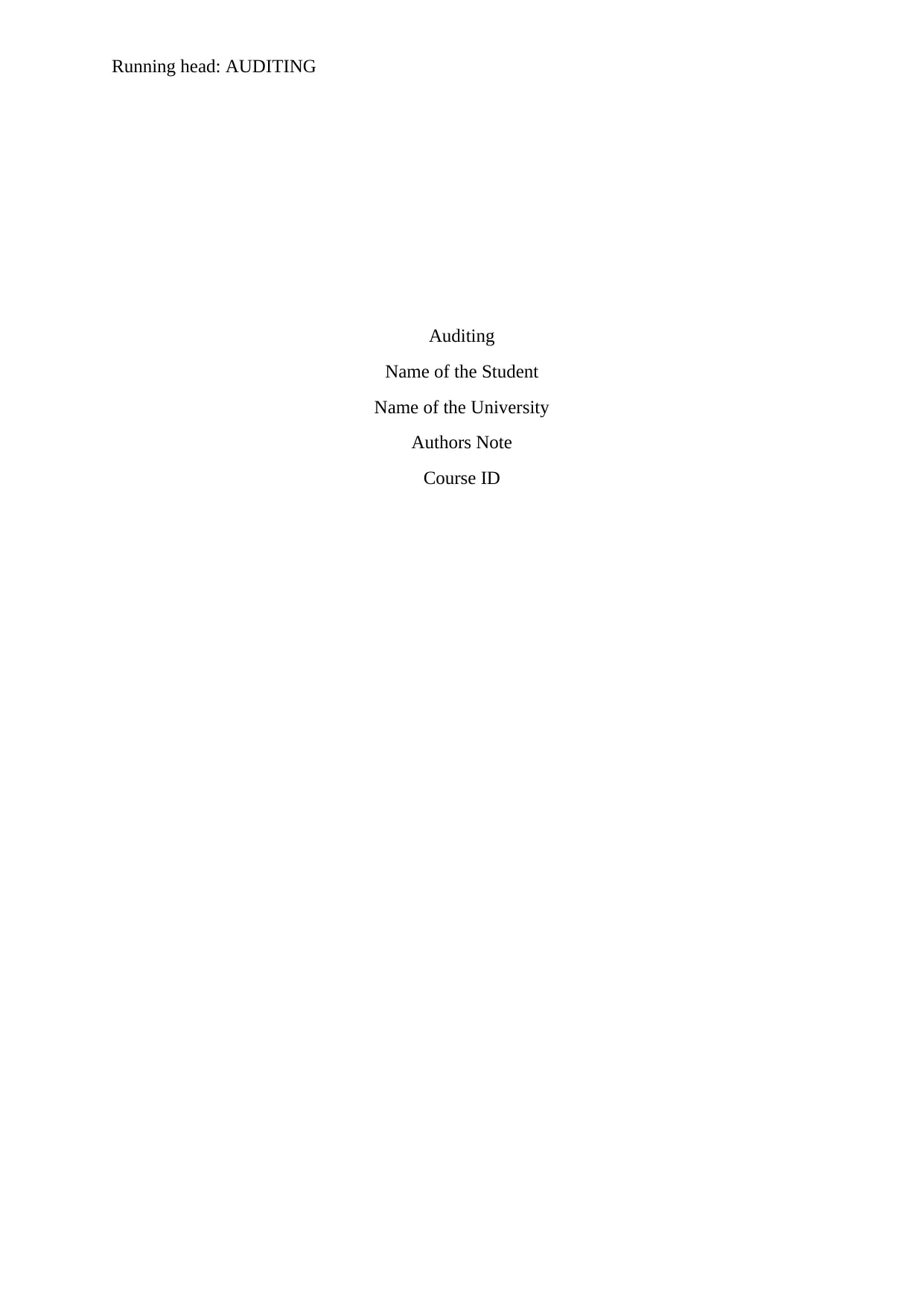
Running head: AUDITING
Auditing
Name of the Student
Name of the University
Authors Note
Course ID
Auditing
Name of the Student
Name of the University
Authors Note
Course ID
Paraphrase This Document
Need a fresh take? Get an instant paraphrase of this document with our AI Paraphraser
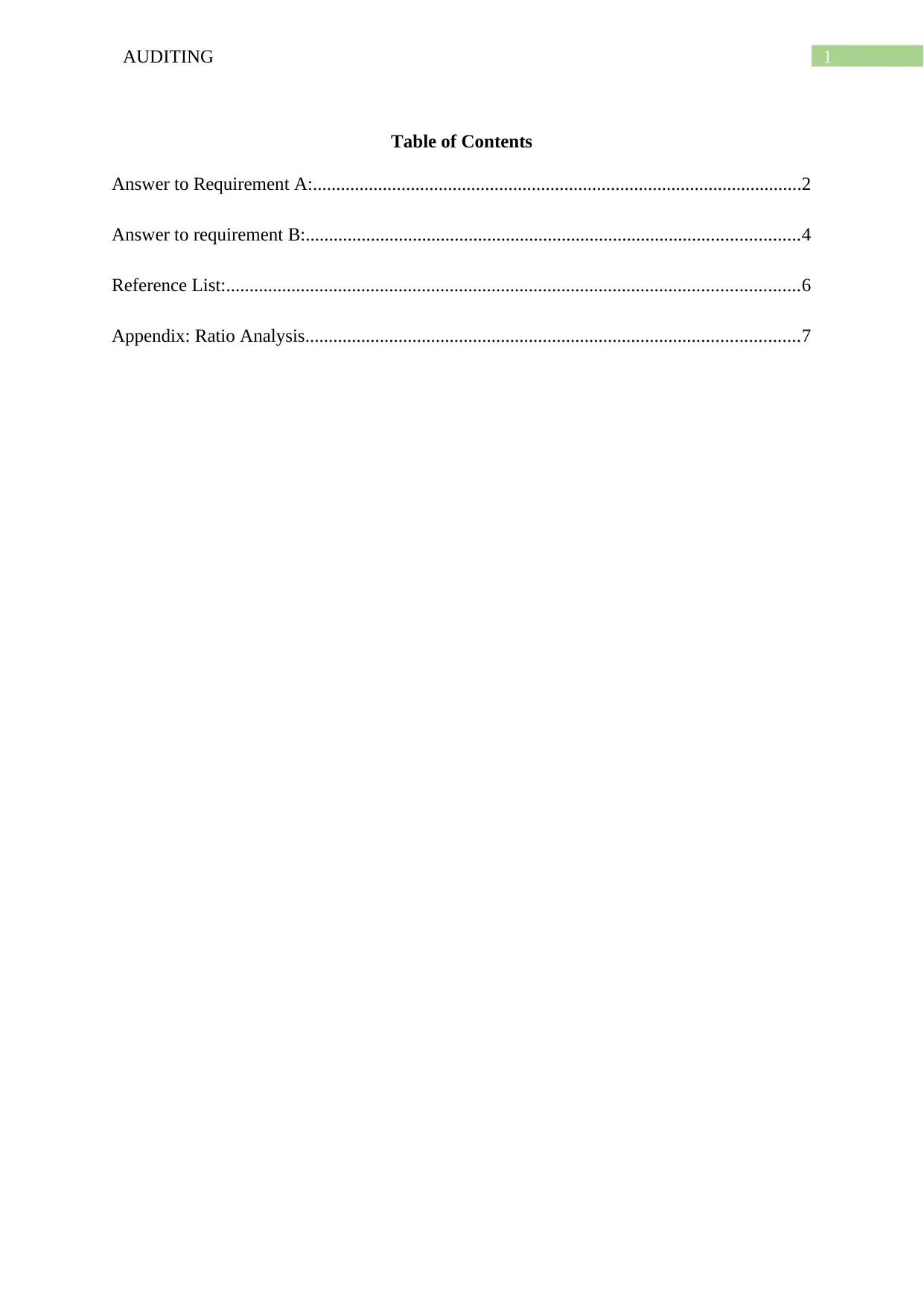
1AUDITING
Table of Contents
Answer to Requirement A:.........................................................................................................2
Answer to requirement B:..........................................................................................................4
Reference List:...........................................................................................................................6
Appendix: Ratio Analysis..........................................................................................................7
Table of Contents
Answer to Requirement A:.........................................................................................................2
Answer to requirement B:..........................................................................................................4
Reference List:...........................................................................................................................6
Appendix: Ratio Analysis..........................................................................................................7
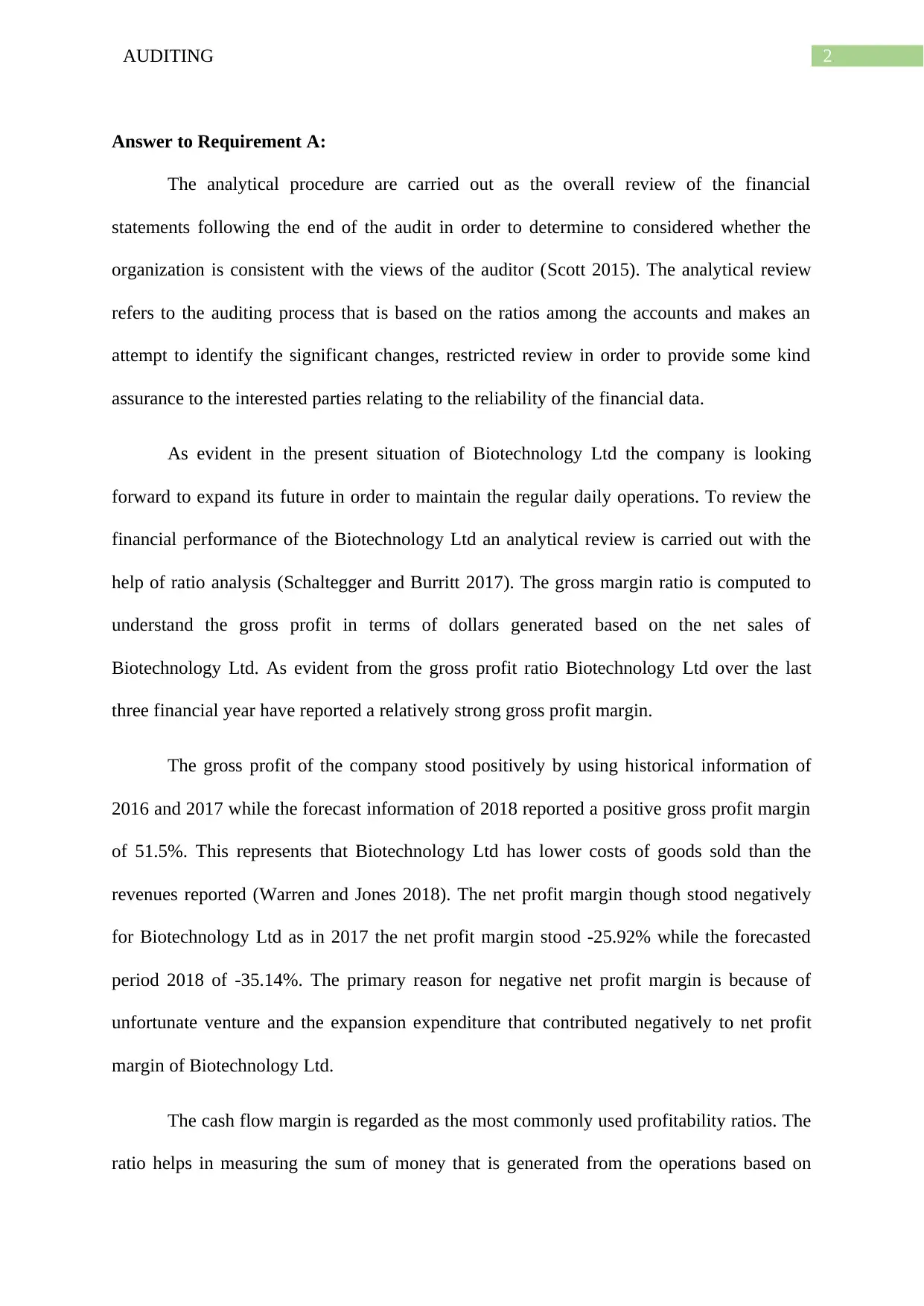
2AUDITING
Answer to Requirement A:
The analytical procedure are carried out as the overall review of the financial
statements following the end of the audit in order to determine to considered whether the
organization is consistent with the views of the auditor (Scott 2015). The analytical review
refers to the auditing process that is based on the ratios among the accounts and makes an
attempt to identify the significant changes, restricted review in order to provide some kind
assurance to the interested parties relating to the reliability of the financial data.
As evident in the present situation of Biotechnology Ltd the company is looking
forward to expand its future in order to maintain the regular daily operations. To review the
financial performance of the Biotechnology Ltd an analytical review is carried out with the
help of ratio analysis (Schaltegger and Burritt 2017). The gross margin ratio is computed to
understand the gross profit in terms of dollars generated based on the net sales of
Biotechnology Ltd. As evident from the gross profit ratio Biotechnology Ltd over the last
three financial year have reported a relatively strong gross profit margin.
The gross profit of the company stood positively by using historical information of
2016 and 2017 while the forecast information of 2018 reported a positive gross profit margin
of 51.5%. This represents that Biotechnology Ltd has lower costs of goods sold than the
revenues reported (Warren and Jones 2018). The net profit margin though stood negatively
for Biotechnology Ltd as in 2017 the net profit margin stood -25.92% while the forecasted
period 2018 of -35.14%. The primary reason for negative net profit margin is because of
unfortunate venture and the expansion expenditure that contributed negatively to net profit
margin of Biotechnology Ltd.
The cash flow margin is regarded as the most commonly used profitability ratios. The
ratio helps in measuring the sum of money that is generated from the operations based on
Answer to Requirement A:
The analytical procedure are carried out as the overall review of the financial
statements following the end of the audit in order to determine to considered whether the
organization is consistent with the views of the auditor (Scott 2015). The analytical review
refers to the auditing process that is based on the ratios among the accounts and makes an
attempt to identify the significant changes, restricted review in order to provide some kind
assurance to the interested parties relating to the reliability of the financial data.
As evident in the present situation of Biotechnology Ltd the company is looking
forward to expand its future in order to maintain the regular daily operations. To review the
financial performance of the Biotechnology Ltd an analytical review is carried out with the
help of ratio analysis (Schaltegger and Burritt 2017). The gross margin ratio is computed to
understand the gross profit in terms of dollars generated based on the net sales of
Biotechnology Ltd. As evident from the gross profit ratio Biotechnology Ltd over the last
three financial year have reported a relatively strong gross profit margin.
The gross profit of the company stood positively by using historical information of
2016 and 2017 while the forecast information of 2018 reported a positive gross profit margin
of 51.5%. This represents that Biotechnology Ltd has lower costs of goods sold than the
revenues reported (Warren and Jones 2018). The net profit margin though stood negatively
for Biotechnology Ltd as in 2017 the net profit margin stood -25.92% while the forecasted
period 2018 of -35.14%. The primary reason for negative net profit margin is because of
unfortunate venture and the expansion expenditure that contributed negatively to net profit
margin of Biotechnology Ltd.
The cash flow margin is regarded as the most commonly used profitability ratios. The
ratio helps in measuring the sum of money that is generated from the operations based on
⊘ This is a preview!⊘
Do you want full access?
Subscribe today to unlock all pages.

Trusted by 1+ million students worldwide
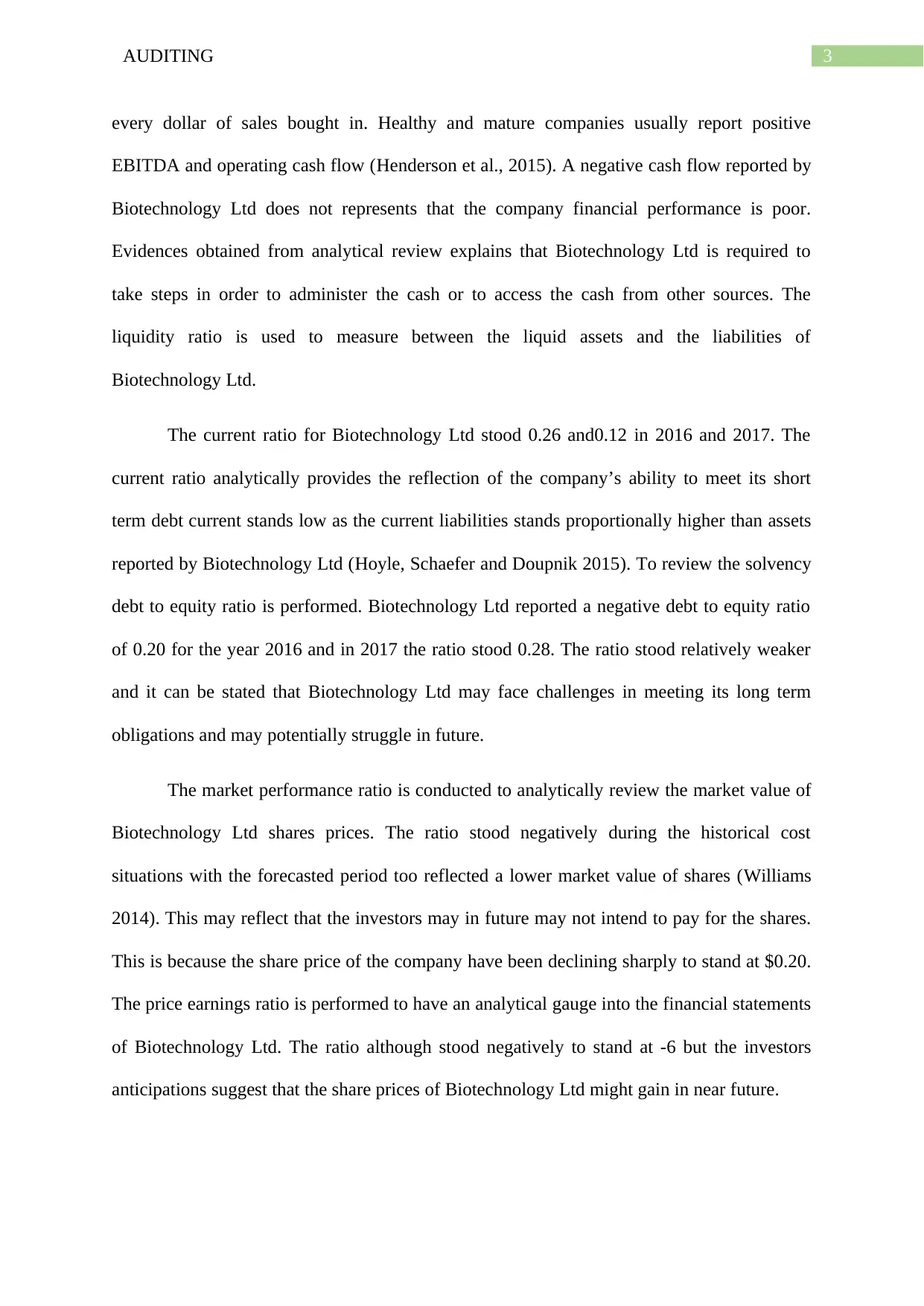
3AUDITING
every dollar of sales bought in. Healthy and mature companies usually report positive
EBITDA and operating cash flow (Henderson et al., 2015). A negative cash flow reported by
Biotechnology Ltd does not represents that the company financial performance is poor.
Evidences obtained from analytical review explains that Biotechnology Ltd is required to
take steps in order to administer the cash or to access the cash from other sources. The
liquidity ratio is used to measure between the liquid assets and the liabilities of
Biotechnology Ltd.
The current ratio for Biotechnology Ltd stood 0.26 and0.12 in 2016 and 2017. The
current ratio analytically provides the reflection of the company’s ability to meet its short
term debt current stands low as the current liabilities stands proportionally higher than assets
reported by Biotechnology Ltd (Hoyle, Schaefer and Doupnik 2015). To review the solvency
debt to equity ratio is performed. Biotechnology Ltd reported a negative debt to equity ratio
of 0.20 for the year 2016 and in 2017 the ratio stood 0.28. The ratio stood relatively weaker
and it can be stated that Biotechnology Ltd may face challenges in meeting its long term
obligations and may potentially struggle in future.
The market performance ratio is conducted to analytically review the market value of
Biotechnology Ltd shares prices. The ratio stood negatively during the historical cost
situations with the forecasted period too reflected a lower market value of shares (Williams
2014). This may reflect that the investors may in future may not intend to pay for the shares.
This is because the share price of the company have been declining sharply to stand at $0.20.
The price earnings ratio is performed to have an analytical gauge into the financial statements
of Biotechnology Ltd. The ratio although stood negatively to stand at -6 but the investors
anticipations suggest that the share prices of Biotechnology Ltd might gain in near future.
every dollar of sales bought in. Healthy and mature companies usually report positive
EBITDA and operating cash flow (Henderson et al., 2015). A negative cash flow reported by
Biotechnology Ltd does not represents that the company financial performance is poor.
Evidences obtained from analytical review explains that Biotechnology Ltd is required to
take steps in order to administer the cash or to access the cash from other sources. The
liquidity ratio is used to measure between the liquid assets and the liabilities of
Biotechnology Ltd.
The current ratio for Biotechnology Ltd stood 0.26 and0.12 in 2016 and 2017. The
current ratio analytically provides the reflection of the company’s ability to meet its short
term debt current stands low as the current liabilities stands proportionally higher than assets
reported by Biotechnology Ltd (Hoyle, Schaefer and Doupnik 2015). To review the solvency
debt to equity ratio is performed. Biotechnology Ltd reported a negative debt to equity ratio
of 0.20 for the year 2016 and in 2017 the ratio stood 0.28. The ratio stood relatively weaker
and it can be stated that Biotechnology Ltd may face challenges in meeting its long term
obligations and may potentially struggle in future.
The market performance ratio is conducted to analytically review the market value of
Biotechnology Ltd shares prices. The ratio stood negatively during the historical cost
situations with the forecasted period too reflected a lower market value of shares (Williams
2014). This may reflect that the investors may in future may not intend to pay for the shares.
This is because the share price of the company have been declining sharply to stand at $0.20.
The price earnings ratio is performed to have an analytical gauge into the financial statements
of Biotechnology Ltd. The ratio although stood negatively to stand at -6 but the investors
anticipations suggest that the share prices of Biotechnology Ltd might gain in near future.
Paraphrase This Document
Need a fresh take? Get an instant paraphrase of this document with our AI Paraphraser
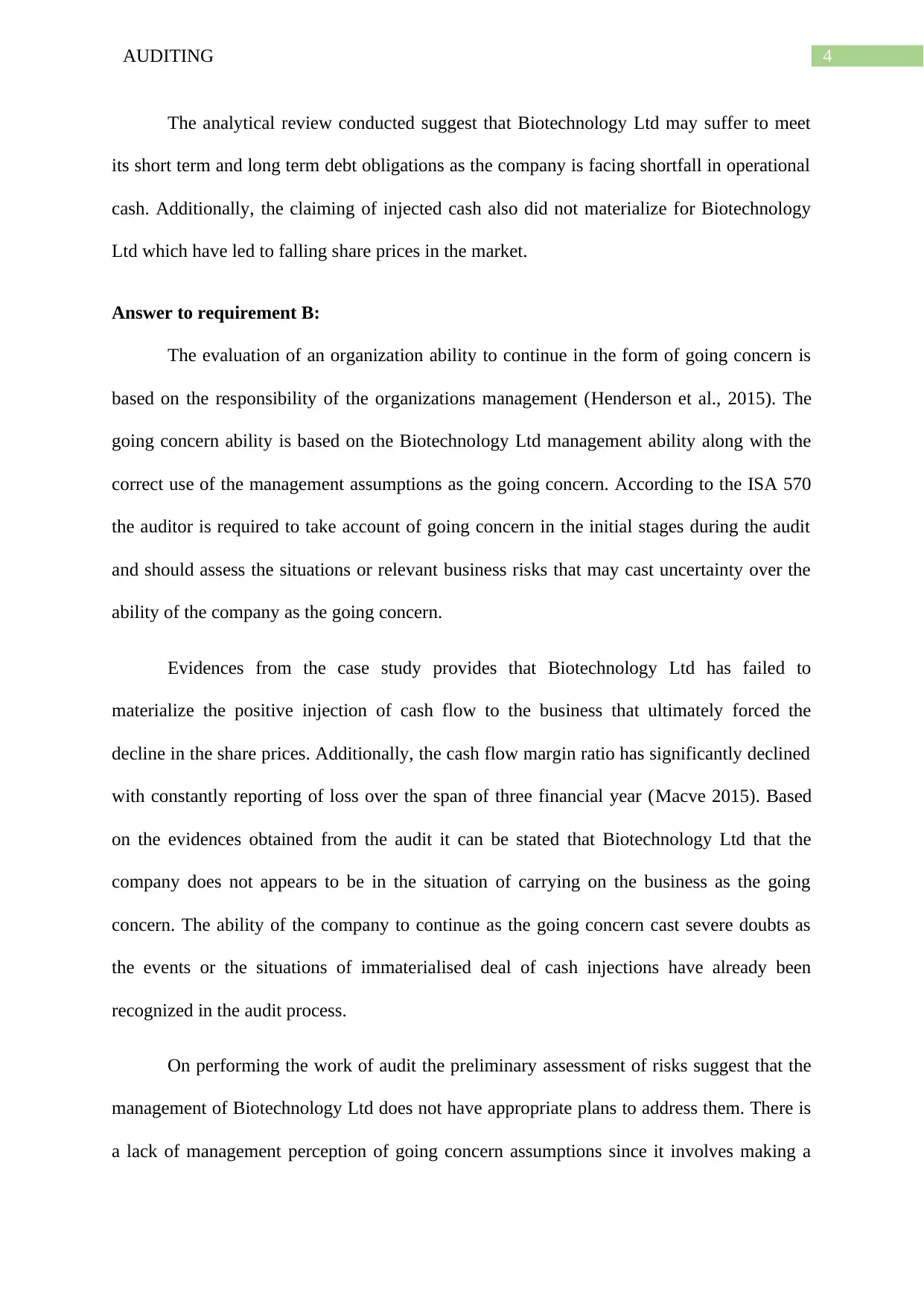
4AUDITING
The analytical review conducted suggest that Biotechnology Ltd may suffer to meet
its short term and long term debt obligations as the company is facing shortfall in operational
cash. Additionally, the claiming of injected cash also did not materialize for Biotechnology
Ltd which have led to falling share prices in the market.
Answer to requirement B:
The evaluation of an organization ability to continue in the form of going concern is
based on the responsibility of the organizations management (Henderson et al., 2015). The
going concern ability is based on the Biotechnology Ltd management ability along with the
correct use of the management assumptions as the going concern. According to the ISA 570
the auditor is required to take account of going concern in the initial stages during the audit
and should assess the situations or relevant business risks that may cast uncertainty over the
ability of the company as the going concern.
Evidences from the case study provides that Biotechnology Ltd has failed to
materialize the positive injection of cash flow to the business that ultimately forced the
decline in the share prices. Additionally, the cash flow margin ratio has significantly declined
with constantly reporting of loss over the span of three financial year (Macve 2015). Based
on the evidences obtained from the audit it can be stated that Biotechnology Ltd that the
company does not appears to be in the situation of carrying on the business as the going
concern. The ability of the company to continue as the going concern cast severe doubts as
the events or the situations of immaterialised deal of cash injections have already been
recognized in the audit process.
On performing the work of audit the preliminary assessment of risks suggest that the
management of Biotechnology Ltd does not have appropriate plans to address them. There is
a lack of management perception of going concern assumptions since it involves making a
The analytical review conducted suggest that Biotechnology Ltd may suffer to meet
its short term and long term debt obligations as the company is facing shortfall in operational
cash. Additionally, the claiming of injected cash also did not materialize for Biotechnology
Ltd which have led to falling share prices in the market.
Answer to requirement B:
The evaluation of an organization ability to continue in the form of going concern is
based on the responsibility of the organizations management (Henderson et al., 2015). The
going concern ability is based on the Biotechnology Ltd management ability along with the
correct use of the management assumptions as the going concern. According to the ISA 570
the auditor is required to take account of going concern in the initial stages during the audit
and should assess the situations or relevant business risks that may cast uncertainty over the
ability of the company as the going concern.
Evidences from the case study provides that Biotechnology Ltd has failed to
materialize the positive injection of cash flow to the business that ultimately forced the
decline in the share prices. Additionally, the cash flow margin ratio has significantly declined
with constantly reporting of loss over the span of three financial year (Macve 2015). Based
on the evidences obtained from the audit it can be stated that Biotechnology Ltd that the
company does not appears to be in the situation of carrying on the business as the going
concern. The ability of the company to continue as the going concern cast severe doubts as
the events or the situations of immaterialised deal of cash injections have already been
recognized in the audit process.
On performing the work of audit the preliminary assessment of risks suggest that the
management of Biotechnology Ltd does not have appropriate plans to address them. There is
a lack of management perception of going concern assumptions since it involves making a
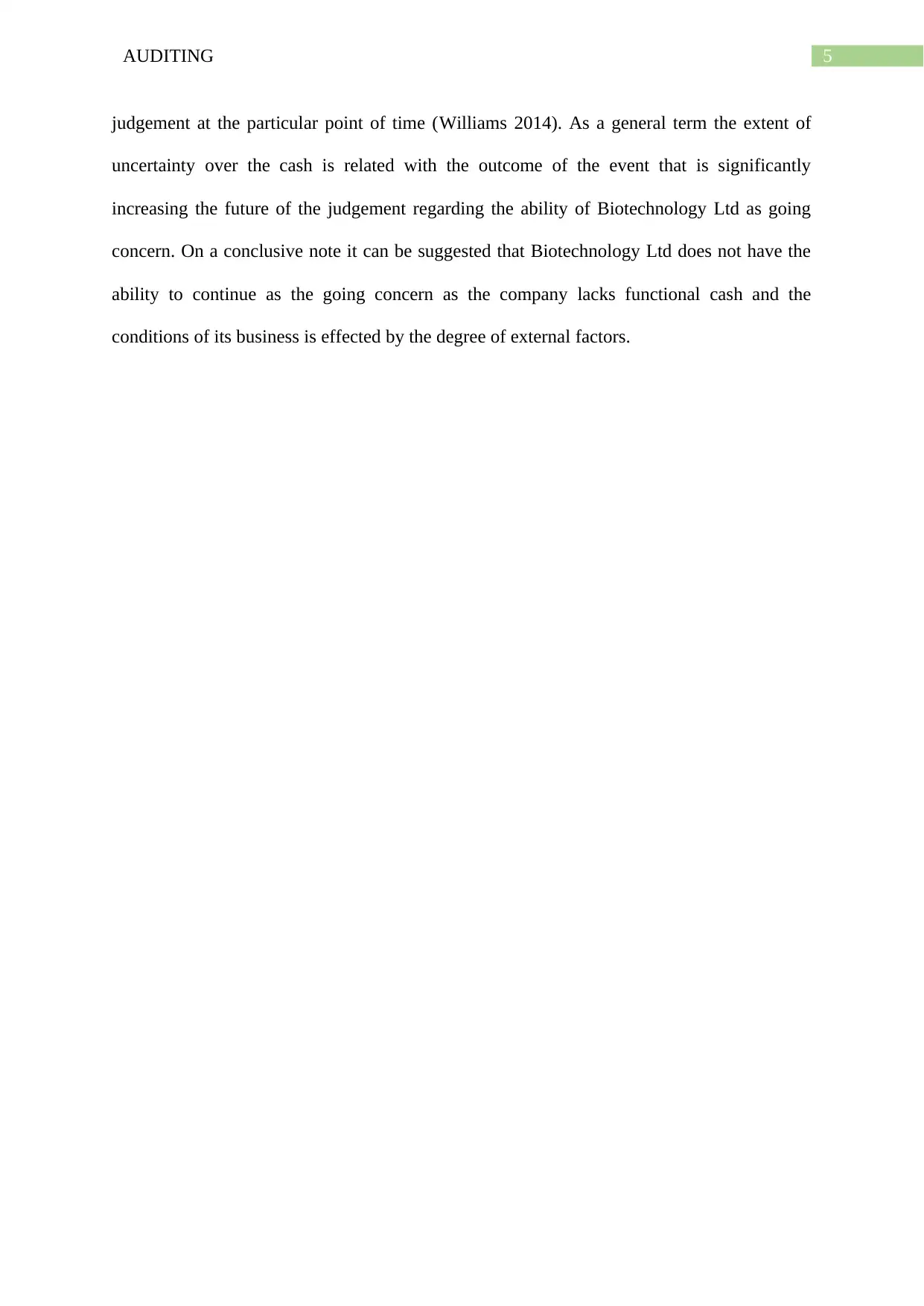
5AUDITING
judgement at the particular point of time (Williams 2014). As a general term the extent of
uncertainty over the cash is related with the outcome of the event that is significantly
increasing the future of the judgement regarding the ability of Biotechnology Ltd as going
concern. On a conclusive note it can be suggested that Biotechnology Ltd does not have the
ability to continue as the going concern as the company lacks functional cash and the
conditions of its business is effected by the degree of external factors.
judgement at the particular point of time (Williams 2014). As a general term the extent of
uncertainty over the cash is related with the outcome of the event that is significantly
increasing the future of the judgement regarding the ability of Biotechnology Ltd as going
concern. On a conclusive note it can be suggested that Biotechnology Ltd does not have the
ability to continue as the going concern as the company lacks functional cash and the
conditions of its business is effected by the degree of external factors.
⊘ This is a preview!⊘
Do you want full access?
Subscribe today to unlock all pages.

Trusted by 1+ million students worldwide

6AUDITING
Reference List:
Henderson, S., Peirson, G., Herbohn, K. and Howieson, B., 2015. Issues in financial
accounting. Pearson Higher Education AU.
Henderson, S., Peirson, G., Herbohn, K. and Howieson, B., 2015. Issues in financial
accounting. Pearson Higher Education AU.
Hoyle, J.B., Schaefer, T. and Doupnik, T., 2015. Advanced accounting. McGraw Hill.
Macve, R., 2015. A Conceptual Framework for Financial Accounting and Reporting: Vision,
Tool, Or Threat?. Routledge.
Schaltegger, S. and Burritt, R., 2017. Contemporary environmental accounting: issues,
concepts and practice. Routledge.
Scott, W.R., 2015. Financial accounting theory (Vol. 2, No. 0, p. 0). Prentice Hall.
Warren, C.S. and Jones, J., 2018. Corporate financial accounting. Cengage Learning.
Williams, J., 2014. Financial accounting. McGraw-Hill Higher Education.
Reference List:
Henderson, S., Peirson, G., Herbohn, K. and Howieson, B., 2015. Issues in financial
accounting. Pearson Higher Education AU.
Henderson, S., Peirson, G., Herbohn, K. and Howieson, B., 2015. Issues in financial
accounting. Pearson Higher Education AU.
Hoyle, J.B., Schaefer, T. and Doupnik, T., 2015. Advanced accounting. McGraw Hill.
Macve, R., 2015. A Conceptual Framework for Financial Accounting and Reporting: Vision,
Tool, Or Threat?. Routledge.
Schaltegger, S. and Burritt, R., 2017. Contemporary environmental accounting: issues,
concepts and practice. Routledge.
Scott, W.R., 2015. Financial accounting theory (Vol. 2, No. 0, p. 0). Prentice Hall.
Warren, C.S. and Jones, J., 2018. Corporate financial accounting. Cengage Learning.
Williams, J., 2014. Financial accounting. McGraw-Hill Higher Education.
Paraphrase This Document
Need a fresh take? Get an instant paraphrase of this document with our AI Paraphraser

7AUDITING
Appendix: Ratio Analysis
Profitability Ratios
Gross Margin (%) 2016 2017 2018
Gross Profit 307 405 515
Sales 615 800 1000
Cost of Goods sold 308 395 485
49.92 50.625 51.5
Net Profit Ratio 2016 2017 2018
Net Profit After tax -3030 -3086 -2845
Sales 615 800 1000
-20.30 -25.92 -35.15
Return on Assets 2016 2017 2018
Net Profit After tax -3030 -3086 -2845
Total Assets 5640 4770 11610
-0.54 -0.65 -0.25
Cash Flow Margin 2017 2018
Net Operating Cash Flow -1973 -1195
Sales 800 1000
-246.63 -119.50
Return on Equity 2016 2017 2018
Net Profit Attributable to Shareholders -3030 -3086 -2845
Equity Investments 26300 26300 26800
-0.12 -0.12 -0.11
Return on Investments 2016 2017 2018
Earnings before interest and tax -3030 -3086 -2845
Total Capital 400 -2686 -5031
-757.50 114.89 56.55
Liquidity Ratio 2016 2017 2018
Current Ratio 2016 2017 2018
Current Assets 1360 870 8660
Current Liabilities 5240 7456 4516
0.26 0.12 1.92
Quick Ratio 2016 2017 2018
Current Assets 1360 870 8660
Less: Inventories 35 20 20
Appendix: Ratio Analysis
Profitability Ratios
Gross Margin (%) 2016 2017 2018
Gross Profit 307 405 515
Sales 615 800 1000
Cost of Goods sold 308 395 485
49.92 50.625 51.5
Net Profit Ratio 2016 2017 2018
Net Profit After tax -3030 -3086 -2845
Sales 615 800 1000
-20.30 -25.92 -35.15
Return on Assets 2016 2017 2018
Net Profit After tax -3030 -3086 -2845
Total Assets 5640 4770 11610
-0.54 -0.65 -0.25
Cash Flow Margin 2017 2018
Net Operating Cash Flow -1973 -1195
Sales 800 1000
-246.63 -119.50
Return on Equity 2016 2017 2018
Net Profit Attributable to Shareholders -3030 -3086 -2845
Equity Investments 26300 26300 26800
-0.12 -0.12 -0.11
Return on Investments 2016 2017 2018
Earnings before interest and tax -3030 -3086 -2845
Total Capital 400 -2686 -5031
-757.50 114.89 56.55
Liquidity Ratio 2016 2017 2018
Current Ratio 2016 2017 2018
Current Assets 1360 870 8660
Current Liabilities 5240 7456 4516
0.26 0.12 1.92
Quick Ratio 2016 2017 2018
Current Assets 1360 870 8660
Less: Inventories 35 20 20

8AUDITING
Current Liabilities 5240 7456 4516
0.25 0.11 1.91
Inventory Turnover Ratio 2016 2017 2018
Cost of Goods Sold -308 -395 -485
Opening Inventory 35 35 20
Closing Inventory 35 20 20
Average Inventory 35 27.5 20
Inventory Turnover Ratio -8.8 -14.36 -24.25
Accounts Receivable Turnover 2016 2017 2018
Openign Receivables 900 900 610
Closing Receivables 900 610 700
Average Receivables 900 755 655
Credit Sales 615 800 1000
534.15 344.47 239.08
Accounts Payable Turnover 2017
Opening Accounts Payable 850
Closing Accounts Payable 906
Average Accounts Payable 878
Credit Purchase -299
-2.94
Solvency Ratio 2016 2017 2018
Debt to Equity Ratio
Total Liabilities 5240 7456 16641
Equity Capital 26300 26300 26800
Debt to Equity Ratio 0.20 0.28 0.62
Market Prospect Ratios 2016 2017 2018
Earnings Per Share
Profit Available for Shareholders -3030 -3086 -2845
Number of Shares outstanding 100000 100000 100250
-0.0303 -0.03086 -0.0283791
Cash EPS 2017 2018
Operating Cash Flow -1973 -1195
Number of shares outstanding 100000 100250
Cash EPS -1.97E-02 -1.19E-02
Price Earnings Ratio 2017
Current Liabilities 5240 7456 4516
0.25 0.11 1.91
Inventory Turnover Ratio 2016 2017 2018
Cost of Goods Sold -308 -395 -485
Opening Inventory 35 35 20
Closing Inventory 35 20 20
Average Inventory 35 27.5 20
Inventory Turnover Ratio -8.8 -14.36 -24.25
Accounts Receivable Turnover 2016 2017 2018
Openign Receivables 900 900 610
Closing Receivables 900 610 700
Average Receivables 900 755 655
Credit Sales 615 800 1000
534.15 344.47 239.08
Accounts Payable Turnover 2017
Opening Accounts Payable 850
Closing Accounts Payable 906
Average Accounts Payable 878
Credit Purchase -299
-2.94
Solvency Ratio 2016 2017 2018
Debt to Equity Ratio
Total Liabilities 5240 7456 16641
Equity Capital 26300 26300 26800
Debt to Equity Ratio 0.20 0.28 0.62
Market Prospect Ratios 2016 2017 2018
Earnings Per Share
Profit Available for Shareholders -3030 -3086 -2845
Number of Shares outstanding 100000 100000 100250
-0.0303 -0.03086 -0.0283791
Cash EPS 2017 2018
Operating Cash Flow -1973 -1195
Number of shares outstanding 100000 100250
Cash EPS -1.97E-02 -1.19E-02
Price Earnings Ratio 2017
⊘ This is a preview!⊘
Do you want full access?
Subscribe today to unlock all pages.

Trusted by 1+ million students worldwide
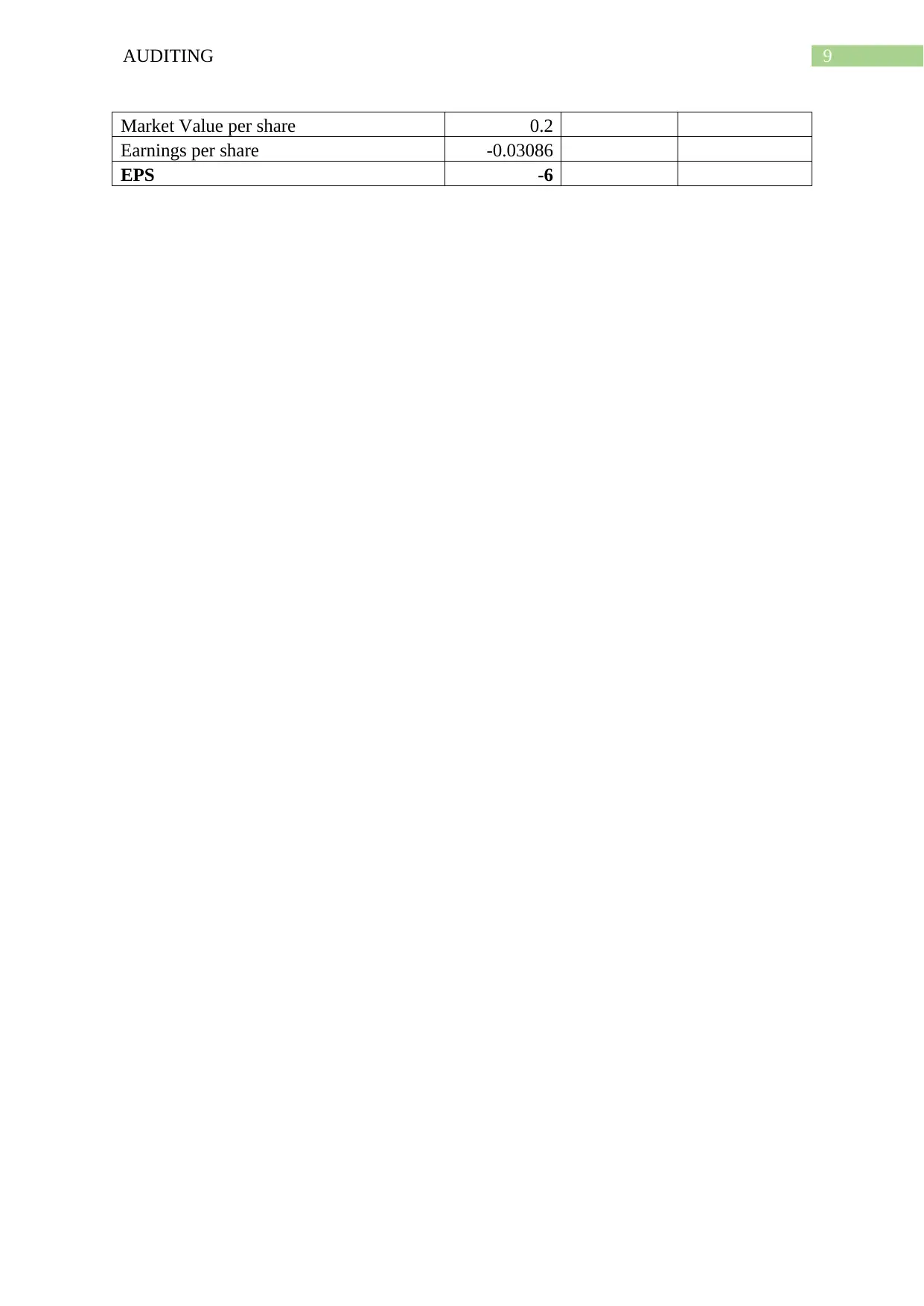
9AUDITING
Market Value per share 0.2
Earnings per share -0.03086
EPS -6
Market Value per share 0.2
Earnings per share -0.03086
EPS -6
1 out of 10
Related Documents
Your All-in-One AI-Powered Toolkit for Academic Success.
+13062052269
info@desklib.com
Available 24*7 on WhatsApp / Email
![[object Object]](/_next/static/media/star-bottom.7253800d.svg)
Unlock your academic potential
Copyright © 2020–2025 A2Z Services. All Rights Reserved. Developed and managed by ZUCOL.





